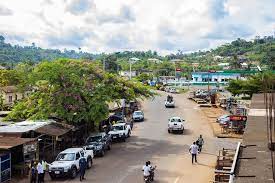Top Qs
Timeline
Chat
Perspective
Sefwi Wiawso
District Capital in Western North Region, Ghana From Wikipedia, the free encyclopedia
Remove ads
Sefwi Wiawso is a town in the Sefwi-Wiawso Municipal District in the Western North Region of Ghana. It serves as the capital of both the Sefwi-Wiawso Municipal District and the southern North Region.[1][2][3] Wiawso serves as the traditional seat for the Omanhene of Sefwi-Wiawso Traditional Area.
The settlement of Wiawso began on hilltop with Sefwi-Dwenase settlement occupying the lowlands. Over time, Wiawso and Sefwi-Dwenase have conurbated with most financial institutions, government offices, lorry terminals, and the main market located in Sefwi-Dwenase.” Wiawso is known for producing timber, cocoa, and cashew.[4]
One of Ghana's 261 Metropolitan, Municipal and District Assemblies (MMDAs), Sefwi Wiawso Municipal is a member of the 22 MMDAs in the Western North Region. Legislative Instrument (L.I) 1386, which was passed on November 23, 1988, formed the Municipality and designated Wiawso as its official capital.[5] Based on the 2021 population and residential census, 151,220 people are living in the Municipality, including 75,905 men and 75,315 women.[5]
Remove ads
History
Summarize
Perspective
The land currently designated Sefwi Wiawso was once covered by a dense forest with an abundance of game and fertile soil. Through hunting, the people discovered the potential of the lands that have now become the Wiawso township. Over time, farmers realized the fertility of the soil and established cocoa farms. Among the early settlers were the family of the then-king Nana Kwasipanin Bumankama and his wife Kooko Adwoa.[6]
The first woman of the land was believed to have established a groundnut farm on top of the hill, allowing it to receive much sunlight at most times of the day. She (the first lady) later named the place of her groundnut farm “Eyia wo so,” which literally meant there is an abundance of sunlight here. This place is now known as Sefwi Wiawso, as the people came to build their homes there. It is believed that Nana Kwasipanin Bumankama came to kill an elephant in the Sefwi Wiawso highlands and raised a high platform for preparing and drying the game. The king later recognized the highlands as a suitable and strategic place for a settlement, having a wide view that would enable him to see approaching enemies in the lowlands.[6]
The people therefore moved and made their new settlement at the Sefwi Wiawso highlands under Nana Bumankama, the sixth king of the Sefwi area. This is the settlement that has developed to become Sefwi Wiawso of today, a land with people especially with passion for agriculture.[6]
Remove ads
Jewish community
Sefwi Wiawso is home to a Jewish community known as the House of Israel. The community maintains the Sefwi Wiawso Synagogue.[7]
Traditional council
The Paramount Chief of Sefwi Wiawso is Katakyire Kwasi Bumangamah II.[8]
Economy
The economy of Wiawso is dominated by agriculture, with about 80% of the working population employed in this sector. The three prominent types of farming activities in this area are livestock farming, food and cash crop farming. The most predominant amongst these cash crop productions is cocoa.[9]
Education
Prominent among the educational institutions in Wiawso are Wiawso College of Education, Sefwi Wiawso Senior High School, Sefwi Wiawso Senior High Technical School and Sefwi Wiawso College of Health.[10]
Landmarks
- The Tree of God (Nyame Dua). The tree of God is located at Nyamebekyere, a distance of about 5 km from Sefwi Wiawso. It is said that about 150 years ago, a farmer struck a machete into the stump of the tree and this is still visible in the trunk of the tree. The tree has continuously been growing ever since, and today the trunk of the tree completely surrounds the machete.[11]
- Abombirim sacred tortoise forest. It is a sacred forest preserve in which a giant tortoise lives. When one sees the tortoise and picks it, there is said to be total darkness in the forest. Until such a time that the tortoise is left for light to re-appear, one will not be able to find a way out of the forest. It is located at Sefwi Boako, a 21 km distance from Sefwi Wiawso.[11]
- Ancestral hole. The ancestral hole is at Sefwi Bosomoiso, about 4 km from Sefwi Wiawso, the capital. It is believed that the royal family of the Bosomoiso community originated from this hole. It is believed to be a bottomless hole surrounded by trees but no leaves fall into it. The hole is alleged to have healing powers (Western region: Human development report 2013 by UNDP).[11][9]
Remove ads
Culture
The chiefs and people of Sefwi-Wiawso traditional area celebrate the Alluolue Festival (Yam, Eluo) to commemorate a historic event.[12] The festival brings people together for the planning of development and to sew bonds of unity and friendship. During the festival, visitors are welcomed to share food and drinks. The people of Sefwi-Wiawso wear traditional clothes and there is durbar of chiefs. There is also dancing and drumming.[13][14] The chiefs settle disputes prior to the festive commemoration to guarantee a smooth event.[15]
Remove ads
References
Wikiwand - on
Seamless Wikipedia browsing. On steroids.
Remove ads


